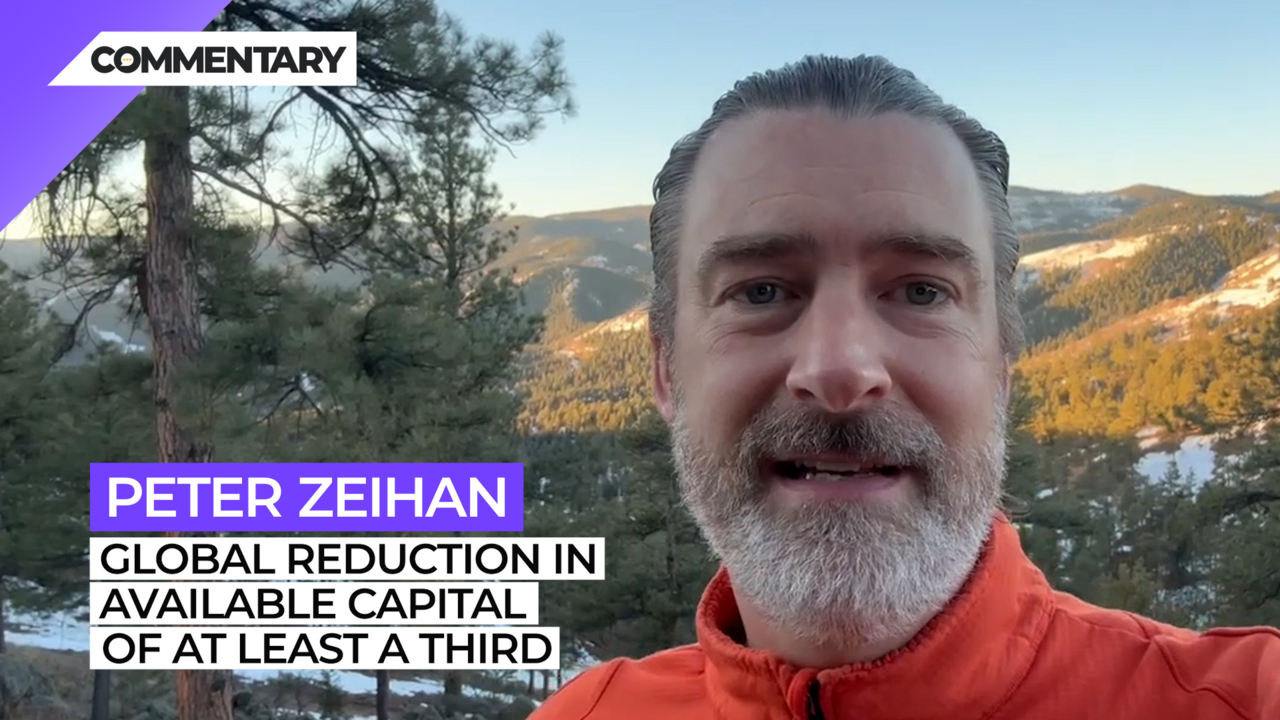
Commentary
-
Our commentary partners will help you reach your own conclusions on complex topics.
Good morning from still chilly Colorado, Peter Zion coming to you to talk about what’s going on in the world of finance. For those of you who have not been watching the US Federal Reserve Chairman, Jerome Powell, has indicated that he plans to shrink the balance sheet down to zero over the course of the next couple of years. So you know, real quick, what’s the balance sheet? And why does it exist? The Federal Reserve prefers to use interest rates and money operations in order to mitigate manipulate the financial system to regulate the flow of capital, the cost of capital, and in general, what happens in the wider world. But from time to time, that is not enough, you can only push interest rates so low, I mean, once you hit zero, there’s really no further to go. And you can only shove so much money into the banking system to encourage lending if people aren’t borrowing, people are not borrowing. So from time to time, certainly at the end, they’re in the middle of the financial crisis and into COVID, the Federal Reserve dipped into a series of relatively unorthodox tools that use the balance sheet. And what they did is they would expand the money supply to print currency, and then use that money to purchase the bonds on the second market make could be car loans, or college loans or credit card debt, mortgages, whatever happened to be, and from 2008 until the peak, which was about probably about two years ago, now. They did $9 trillion that way. So you know, the US federal budget deficit is a trillion. So you can get an idea of just how stimulatory that was. And there were a lot of people who thought that this was irresponsible, and then it was inflationary, and was another word unorthodox. And you know, they have a point. But from the Federal Reserve’s point of view, the alternative was to fall into a deep recession, or maybe even depression, and didn’t feel they had much of a choice. What’s going on now is the economy’s on sounder footing, we are at record low unemployment levels. And growth has been moderate to strong for three years in a row. So the Federal Reserve feels it’s time to kind of get out of that business and get back to normal. And if from the point that they really started this process a year ago to two years being done three year process, you know, that’s like three, four times as fast as they built the thing up. So really quick, actually, when you’re thinking about the size of this $9 trillion, that’s a lot. Now, what will that mean? It should, under normal circumstances typically means slower economic growth, because when you reduce the cost of capital, less stuff gets funded, and the stuff that does get funded, tends to be more viable. So more industrial plant more infrastructure, more education, less on things that are like emerging technologies that haven’t made it to the prototype stage, yet less on technologies that don’t seem to be working out in terms of cost benefit analysis. Over all, from an economic efficiency point of view, this is a really good step, because shaking out some of the deadweight that has evolved in this environment we’ve had for the last 15 years of nearly free capital, you know, we’ve seen a lot of crazy shit go down. And we’re finally going to see a lot of that get shaken out where you interest rates are getting back to a more normal posture. The Fed has not done raising, he’s got at least another full percentage point to go, I would argue probably closer to three. And we’re finally seeing all this surplus liquidity go out of the system and return us to a more balanced system, which means when we get to the next financial crisis or the next recession, the Fed will have a lot more tools, a lot more wiggle room and the overall economy will be a lot healthier, these are all good things. But what is good for the system as a whole is not necessarily good for each individual piece. So think of all the things that we have seen bubble up over the last 15 years because of cheap capital. In part this is the Green Revolution technologies that on a cost benefit basis once you include things like intermittency and geography and are not really ready for primetime EVs which are very materials intensive and tap supply chains that are not secure that we want to produce at scale even though their carbon footprint in a lot of the country is heavier than ice internal combustion engines for at least several years. And then you’ve got your more traditional crap your your subprime your beanie babies, your your Bitcoin things that probably should have never existed in the first place. All of that is going to be in a much more difficult capital environment. And we should expect that to adjust appropriately. But perhaps where we’re gonna see the most pain is in finance. When the amount of money to be managed shrinks, the number of money managers that you need, goes down. And it’s not like the Federal Reserve is the only player here. There are other things going on in the overall economic system that are also pushing us in the direction of less capital. I’d say the single biggest one may be even more significant than the Federal Reserve in the long term is what’s happening with the baby boomers. As you get old Are you get better at your job, you earn more money. And after age 50 to 55, your kids have moved out of your house has been paid down. So from 55 to 65. That’s the most money you’ll ever have in your life. And then you retire. And when you retire, you take your money out of more prospective investments with higher velocity of capital, things like stocks and bonds, and you put them into T bills in cash, because the next time there’s a market crash, if you haven’t done that, you lose your shirt, and you’re no longer working and you can’t buy a new one. So the baby boomers for the last 15 years have kind of been in that magical area between 55 and 65, where they’ve been saving money and investing. And that has happened at the same time that the Federal Reserve has maintained an ultra loose monetary policy. Well, on average, the baby boomers retired last year, which means that their money is rapidly draining away from the system at the same time that the Federal Reserve is tightening policy. So over the course of the next two to three years, we’re looking at a global reduction in available capital of at least a third. And we will probably see the number of people employed in the financial sector in the United States dropped by a similar number. Good luck, folks. It’s going to be all about quality moving forward. Alright, until next time,
-
Hurricane Helene hits US coast, Appalachia and beyond
Hurricane Helene hit Florida and Georgia overnight between Sept. 26 and 27 as a Category 4 hurricane, and accompanying storms will continue reaching deeper into the continental United States today. Dangerous flash flooding from the hurricane, known as storm surge, was some of the worst flooding that the Tampa Bay area has ever seen, and… -
Israel holds upper hand against Lebanon, Hezbollah and Iran
On Wednesday, Sept. 25, Hezbollah launched a ballistic missile at Tel Aviv in retaliation for Israel’s explosive pager attack that blew up devices across Lebanon. Although Israel’s defense systems intercepted the surface-to-surface missile, the attempted strike on Tel Aviv marked a significant escalation by Hezbollah. Since the siege on Gaza began, shortly after the Oct. 7, 2023,… -
The Sinaloa Cartel civil war
Fears of a civil war within the Sinaloa Cartel are growing as violence between competing factions within the cartel continues. The Mexican Army has dispatched around 600 elite troops to Sinaloa to help quell those fears, in addition to roughly 2,200 regular soldiers and National Guard. Watch the above video as Straight Arrow News contributor… -
New Ukrainian weapons hit Russia where it hurts
Ukrainian drones struck a major Russian ammunition depot, triggering a massive explosion that was captured on camera. According to the Ukrainian military, 2,000 tons of munitions had arrived at the depot before the attack. Over the past two years, Ukraine has significantly increased its domestic drone production, allowing it to scale up attacks on military… -
Weighing social costs vs. economic benefits on immigration
Global human migration is one of the defining elements of our current historical era, according to the United Nations. Migrants face both the incentives to leave — forced out by climate change, crime and corruption, extreme poverty or violence — and incentives for where to go, based on available job opportunities and so on. Migration…
Latest Stories
-
 Getty Images
Getty Images
Jay-Z sues sexual assault accuser and lawyer, says Roc Nation lost $20 million
-
 Getty Images
Getty Images
Democrats want DOJ attorney who dropped Eric Adams case investigated
-
 Getty Images
Getty Images
Millions of users’ personal data shared with US law enforcement: Report
-
 Getty Images
Getty Images
Republican leaders urge a pause on town hall meetings
-
 Getty Images
Getty Images
Media spins Trump, Zelenskyy Oval Office meeting: Bias Breakdown
Popular Opinions
-
In addition to the facts, we believe it’s vital to hear perspectives from all sides of the political spectrum.
Latest Opinions
In addition to the facts, we believe it’s vital to hear perspectives from all sides of the political spectrum. We hope these different voices will help you reach your own conclusions.
The opinions published in this section are solely those of the contributors and do not reflect the views of Straight Arrow News.





















Latest Commentary
We know it is important to hear from a diverse range of observers on the complex topics we face and believe our commentary partners will help you reach your own conclusions.
The commentaries published in this section are solely those of the contributors and do not reflect the views of Straight Arrow News.
Dr. Frank Luntz
Pollster and Political Analyst‘Biased’: What Americans think of ‘mainstream media’
‘Getting rid of them’: Americans discuss Trump and immigration
‘Woke’: Why some Biden 2020 voters backed Trump in 2024